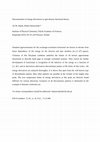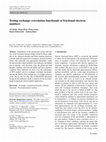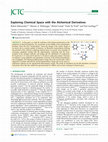Papers by Robert Balawender

Density Functional Theory
An overview is given of our recent work on the linear response function (LRF) χ r; r 0 ðÞ and its... more An overview is given of our recent work on the linear response function (LRF) χ r; r 0 ðÞ and its congener, the softness kernel s r; r 0 ðÞ , the second functional derivatives of the energy E and the grand potential Ω with respect to the external potential at constant N and μ, respectively. In a first section on new insights into the LRF in the context of conceptual DFT, the mathematical and physical properties of these kernels are scrutinized through the concavity of the E ¼ EN; v ½ and Ω ¼ Ω μ; v ÂÃ functionals in v r ðÞresulting, for example, in the negative semidefiniteness of χ. As an example of the analogy between the CDFT functionals and thermodynamic state functions, the analogy between the stability conditions of the macroscopic Gibbs free energy function and the concavity conditions for Ω is established, yielding a relationship between the global and local softness and the softness kernel. The role of LRF and especially the softness kernel in Kohn's nearsightedness of electronic matter (NEM) principle is highlighted. The first numerical results on the softness kernel for molecules are reported and scrutinized for their nearsightedness, reconciling the physicists' NEM view and the chemists' transferability paradigm. The extension of LRF in the context of spin polarized conceptual DFT is presented. Finally, two sections are devoted to 'new horizons' for the LRF. The role of LRF in (evaluating) alchemical derivatives is stressed, the latter playing a promising role in exploring the chemical compound space. Examples for the transmutation of N 2 and the CC ! BN substitution pattern in 2D and 3D carbocyclic systems illustrate the computational efficiency of the use of alchemical derivatives in exploring nearest neighbours in the chemical compound space. As a second perspective, the role of LRF in evaluating and interpreting molecular conductivity is described. Returning to its forerunner, Coulson's atom-atom polarizability, it is shown how in conjugated π systems (and within certain approximations) a remarkable integralintegrand relationship between the atom-atom polarizability and the transmission probability between the atoms/contacts exists, leading to similar trends in both properties. A simple selection rule for transmission probability in alternating hydrocarbons is derived based on the sign of the atom-atom polarizability.
Acta Physica Polonica A, 1995
Dedicated o Professors Krzyszof Pigoń, Jdsef W. Rohleder and Zdzisław Ruziewicz on the occasion o... more Dedicated o Professors Krzyszof Pigoń, Jdsef W. Rohleder and Zdzisław Ruziewicz on the occasion of their 7θth birthday? The electronic structures of fluoroperovskite KMgF 3 , hydridoperovskite KMgH3 and the dihydrido-fluoro derivated KΜgH 2 F have been investigated. The energy bands, density of electronic states and partial wave analysis of the density of electronic states have been determined by means of the non-self-consistent augmented plane wave method with the von Barth-Hedin parametrization for the exchange-correlation term. Our results indicate that all three ckpounds are ionic insulators. Replacing the hydrogen atom by fluorine atom leads to increasing in the energy gap.

Standard approximations for the exchange-correlation functional are known to deviate from linear ... more Standard approximations for the exchange-correlation functional are known to deviate from linear dependence of the energy on the electron and spin numbers (in -space). Violation of this flat-plane condition underlies the failure of all known approximate functionals to describe band gaps in strongly correlated systems. Then crucial for further development of functionals is recognition of the behavior of the energy as a function of, and its derivatives (derivatives discontinuity pattern at 0K limit). In this Letter, the energy derivatives are analyzed thoroughly. It is shown that apart from the well-known type of discontinuity pattern, three other patterns are possible in the vicinity of the singlet state point. The zero temperature limits of energy derivatives at this point are derived, found different for various directions. Existence of all discontinuity patterns is illustrated on the example of diatomic molecules set.

Theoretical Chemistry Accounts, 2014
Dependence of the ground-state energy and density on the fractional electron number should be lin... more Dependence of the ground-state energy and density on the fractional electron number should be linear, while that of the chemical potential and Fukui function should be constant within the region between integers. In practical calculations with commonly used approximate functionals, results deviate from these ideal conditions. Four indicators are defined here to measure such deviations: from the global and local linearity condition, and from the global and local constancy condition. These indicators are used to test the performance of DFT method with five exchange-correlation functionals, and also the Hartree-Fock method, on a set of high-symmetry atoms: He, Li, Be, Na, Mg. The rCAM-B3LYP functional, having all four indicators small, is found to be the best functional for fractional electron number applications. Keywords Exchange-correlation potentials • Density functional • Fractional particle number Dedicated to Professor Guosen Yan and published as part of the special collection of articles celebrating his 85th birthday.

The Journal of chemical physics, Jan 7, 2015
The chemical reactivity indices as the equilibrium state-function derivatives are revisited. They... more The chemical reactivity indices as the equilibrium state-function derivatives are revisited. They are obtained in terms of the central moments (fluctuation formulas). To analyze the role of the chemical hardness introduced by Pearson [J. Am. Chem. Soc. 105, 7512 (1983)], the relations between the derivatives up to the third-order and the central moments are obtained. As shown, the chemical hardness and the chemical potential are really the principal indices of the chemical reactivity theory. It is clear from the results presented here that the chemical hardness is not the derivative of the Mulliken chemical potential (this means also not the second derivative of the energy at zero-temperature limit). The conventional quadratic dependence of energy, observed at finite temperature, reduces to linear dependence on the electron number at zero-temperature limit. The chemical hardness plays a double role in the admixture of ionic states to the reference neutral state energy: it determines...
Phys. Chem. Chem. Phys., 2014
The usefulness of the information and complexity measure in molecular reactivity studies.
Reviews of Modern Quantum Chemistry, 2002
ABSTRACT Conclusion The nuclear Fukui function provides an interesting tool for studying the inte... more ABSTRACT Conclusion The nuclear Fukui function provides an interesting tool for studying the interplay between electronic and nuclear rearrangements upon chemical reactions. As finite difference and analytical methodologies to compute numerical values are nowadays available, the nuclear Fukui function can be routinely studied in the future, serving as a companion to electronic DFT based reactivity descriptors.
The Journal of Physical Chemistry A, 1998
Derivatives of the molecular valence have been calculated ab initio within the new non-finite-dif... more Derivatives of the molecular valence have been calculated ab initio within the new non-finite-difference approach elaborated on earlier for the global hardness and the Fukui function indices. The group of 10 five-membered-ring molecules C 4 H 4 X has been chosen for a test, using the exaltation of the total magnetic susceptibility (Λ) as a reference measure of their aromaticity. An excellent correlation has been found between the molecular valence derivatives in the nucleophilic regime and the exaltation Λ, for both the aromatic and antiaromatic molecules. Calculation of the valence derivatives provides an absolute measure of aromatic character that is not directly dependent on the size of the molecule and does not require adopting any standard reference molecule.

The Journal of Physical Chemistry A, 2001
The effective fragment potential (EFP) model has been used to study the effect of adding increasi... more The effective fragment potential (EFP) model has been used to study the effect of adding increasing numbers of the water molecules on several DFT-based reactivity descriptors of NH 3. The HOMO-LUMO gap and electrophilic hardness are seen to increase with addition of water molecules. The importance on the wave function relaxation in the solvent effect on ammonia's properties is shown when analyzing the relaxation part in the electrophilic hardness and condensed Fukui function for the nitrogen atom. An increase in the atomic softness for the nitrogen atom with decreasing the global softness is observed. The saturation point for solvatation of ammonia was located around a cluster with 16 molecules of water. Atomic properties such as the Mulliken population, condensed Fukui function, and atomic softness for nitrogen and electrophilic global properties such as the hardness and its components for dilute solutions are predicted faithfully.

The Journal of Physical Chemistry A, 2001
The effect of solvent on the electronegativity, hardness, and condensed Fukui function, and atomi... more The effect of solvent on the electronegativity, hardness, and condensed Fukui function, and atomic softness for a set of diatomic and small polyatomic molecules and ions has been studied using the effective fragment potential (EFP) model. The binding function was used for monitoring the solvation of the molecule. We do not observe a decrease in the HOMO-LUMO gap in the solvent. All anions show a significant change in the chemical potential. Both HOMO and LUMO energy levels decrease in the solvent phase as compared to the gas phase. For the major part of the acids, the increase in the LUMO orbital energy is larger than in the HOMO orbital energy. For the group of salts, we observe an increase in the LUMO energy level and a similar decrease in the HOMO energy level, resulting in a small change in the chemical potential. The importance of the change in the wave function upon solvation was shown through an analysis of the relaxation part in the hardness and condensed Fukui function. Very close values found for the same ions in molecules such as LiH, LiF, NaH, NaF, and LiF indicate that in these cases very good separated ion pairs are present.
Physical Review A, 2002
In a recent paper, Maitra and Burke ͓Phys. Rev. A 63, 042501 ͑2001͒; 64, 039901͑E͒ ͑2001͔͒ have g... more In a recent paper, Maitra and Burke ͓Phys. Rev. A 63, 042501 ͑2001͒; 64, 039901͑E͒ ͑2001͔͒ have given an interesting and instructive example that illustrates a specific feature of the time-dependent density-functional theory-the dependence of the reconstructed time-dependent potential not only on the electron density, but also on the initial state of the system. However, a concise form of its presentation by these authors is insufficient to reveal all its peculiarities. Our paper represents a very detailed study of this valuable example, intended to facilitate a better understanding and appreciation.

Journal of Chemical Theory and Computation, 2013
In this paper, we verify the usefulness of the alchemical derivatives in the prediction of chemic... more In this paper, we verify the usefulness of the alchemical derivatives in the prediction of chemical properties. We concentrate on the stability of the transmutation products, where the term "transmutation" means the change of the nuclear charge at an atomic site at constant number of electrons. As illustrative transmutations showing the potential of the method in exploring chemical space, we present some examples of increasing complexity starting with the deprotonation, continuing with the transmutation of the nitrogen molecule, and ending with the substitution of isoelectronic B−N units for C−C units and N units for C−H units in carbocyclic systems. The basis set influence on the qualitative and quantitative accuracies of the alchemical predictions was investigated. The alchemical deprotonation energy (from the second order Taylor expansion) correlates well with the vertical deprotonation energy and can be used as a preliminary indicator for the experimental deprotonation energy. The results of calculations for the BN derivatives of benzene and pyrene show that this method has great potential for efficient and accurate scanning of chemical space.

The Journal of Chemical Physics, 2005
A derivation of the density-functional-theory- (DFT) based reactivity indices in the ensemble unr... more A derivation of the density-functional-theory- (DFT) based reactivity indices in the ensemble unrestricted Hartree-Fock (eUHF) method is presented. The comparison between the properties of the reactivity indices evaluated in one and two sets of spin-orbital approach of the eUHF and hyper-unrestricted Hartree-Fock (UHF) methods are shown. All approaches give similar Fukui function irrespective of methodology used, but significantly differ for the global indices, containing important chemical information, and so their interpretation in terms of DFT- based indices can be questionable. The calculation scheme for the indices using the first- and second-order coupled perturbed eHF equations is proposed. A method for the identification of the spinorbitals involved in the change of the total number of electrons is included. The illustrative examples (water and hydrogen cyanide) show that the ground-state (GS) properties of the (Z±1)-electron systems can be predicted from the GS properties o...
The Journal of Chemical Physics, 2005
Correct evaluation of the reactivity indices, such as chemical potential, hardness, and Fukui fun... more Correct evaluation of the reactivity indices, such as chemical potential, hardness, and Fukui function demands for the extension of the formalism beyond the integer particle picture. An ensemble approach is used as an extension of the unrestricted Hartree-Fock (UHF) method for noninteger electron number systems. A prescription is given for the construction of an ensemble Fock operator for a system with partially filled spin-orbitals. The comparison between the ensemble HF method and the hyper-HF method in terms of density matrices and spin-orbitals is presented. The equivalence of the equiensemble case and the ensemble UHF case with unequal weight factors is shown.
The Journal of Chemical Physics, 2006
In this Comment the authors propose an alternative formulation of the starting point to the analy... more In this Comment the authors propose an alternative formulation of the starting point to the analysis performed in the commented paper [P. W. Ayers and W. Yang, J. Chem. Phys.124, 224108 (2006)]. An important role of the z component of the vector of the total spin angular momentum operator for the considered many-electron system is indicated. The authors believe their approach to be mathematically cleaner and conceptually easier than the original treatment.
The Journal of Chemical Physics, 2001
The properties of the derivative of the total binding function (the virial of the forces) with re... more The properties of the derivative of the total binding function (the virial of the forces) with respect to the number of electrons and its decomposition at local and atomic level have been analyzed. At local level the binding function is expressed by the Berlin function fv(r) and the electronic Fukui function f(r). The atomic analog is expressed in terms of the nuclear Fukui function (FF) and the nuclear position vectors. A relationship between the local maps of fv(r)f(r), the nuclear FF vectors, and the Jahn–Teller distortion direction is discussed. It is predicted that upon ionization the symmetry of the nearest local stationary point for BH3 is C2v, for AH4 molecules (CH4 and SiH4) D2d, and for C3H6 C2v. For the benzene anion a D2h symmetry is predicted.

The Journal of Chemical Physics, 2001
A calculation scheme of the nuclear Fukui function via a coupled perturbed Hartree–Fock approach ... more A calculation scheme of the nuclear Fukui function via a coupled perturbed Hartree–Fock approach is proposed avoiding the finite difference approach in DFT-based descriptors. Nucleophilic and electrophilic nuclear Fukui functions are compared with the numerical approximation for the nuclear Fukui function (FF) as the negative derivative of the chemical potential with respect to the atomic coordinates and as the derivative of the Helman–Feynman force with respect to the total number of electrons. The results for a set of diatomic molecules are shown. Analytical and numerical techniques do show a high correlation. Overall, values from both numerical methods are larger than those from the analytical one. The analytical results can be interpreted in terms of the character of the orbital involved during ionization or adding of electrons; the change in the equilibrium bond length upon ionization, which is positive for bonding orbitals and negative for antibinding orbitals is connected wit...

The Journal of Chemical Physics, 2012
We present an analytical approach to treat higher order derivatives of Hartree-Fock (HF) and Kohn... more We present an analytical approach to treat higher order derivatives of Hartree-Fock (HF) and Kohn-Sham (KS) density functional theory energy in the Born-Oppenheimer approximation with respect to the nuclear charge distribution (so-called alchemical derivatives). Modified coupled perturbed self-consistent field theory is used to calculate molecular systems response to the applied perturbation. Working equations for the second and the third derivatives of HF/KS energy are derived. Similarly, analytical forms of the first and second derivatives of orbital energies are reported. The second derivative of Kohn-Sham energy and up to the third derivative of Hartree-Fock energy with respect to the nuclear charge distribution were calculated. Some issues of practical calculations, in particular the dependence of the basis set and Becke weighting functions on the perturbation, are considered. For selected series of isoelectronic molecules values of available alchemical derivatives were compute...
International Journal of Quantum Chemistry, 1997
Hardness of a molecule has been formulated as an average of a set of terms representing various t... more Hardness of a molecule has been formulated as an average of a set of terms representing various types of reactivity. Hardness parameters for molecules and bonded atoms have been calculated by the ab initio Hartree-Fock self-consistent field (HF SCF) method. An analysis has been ...









Uploads
Papers by Robert Balawender